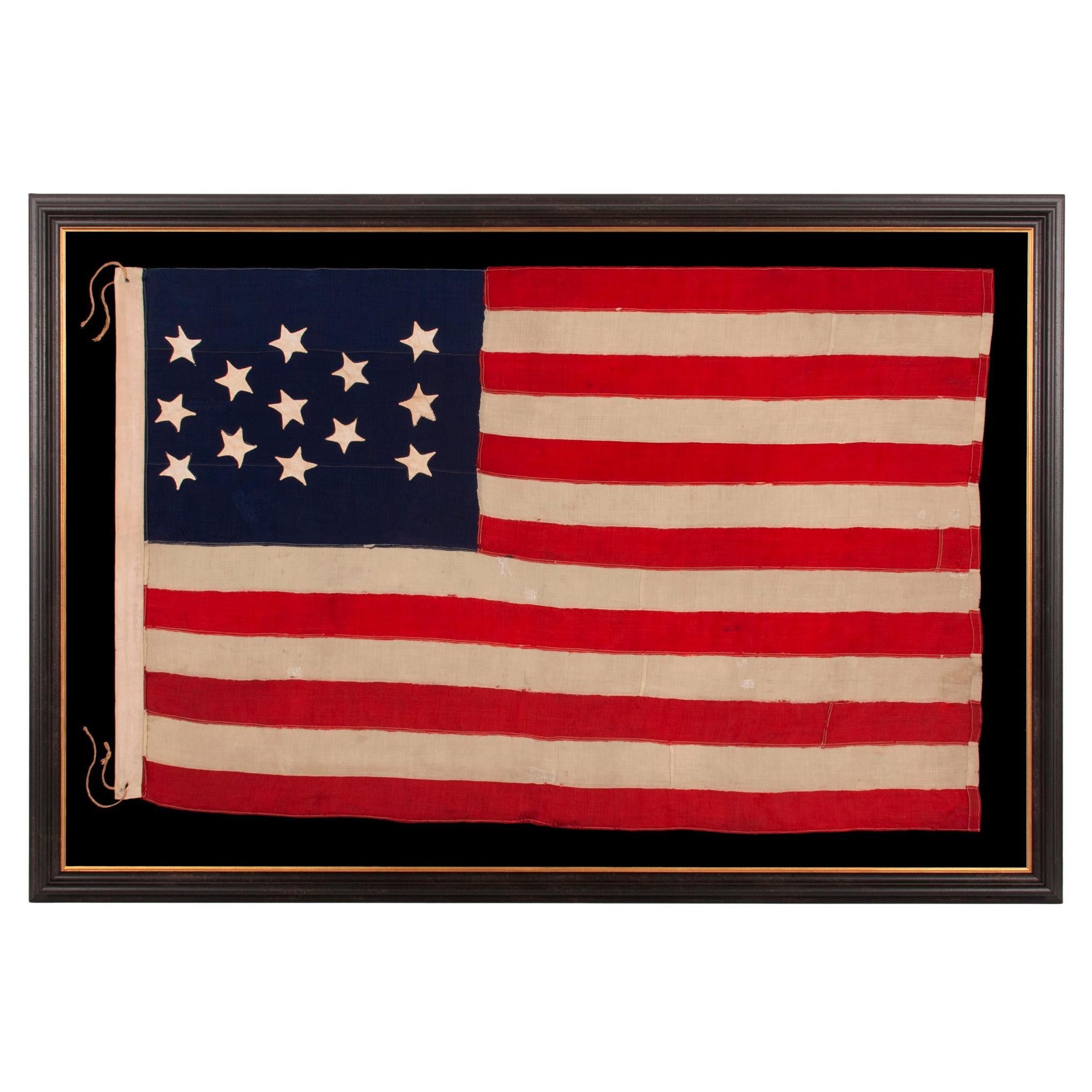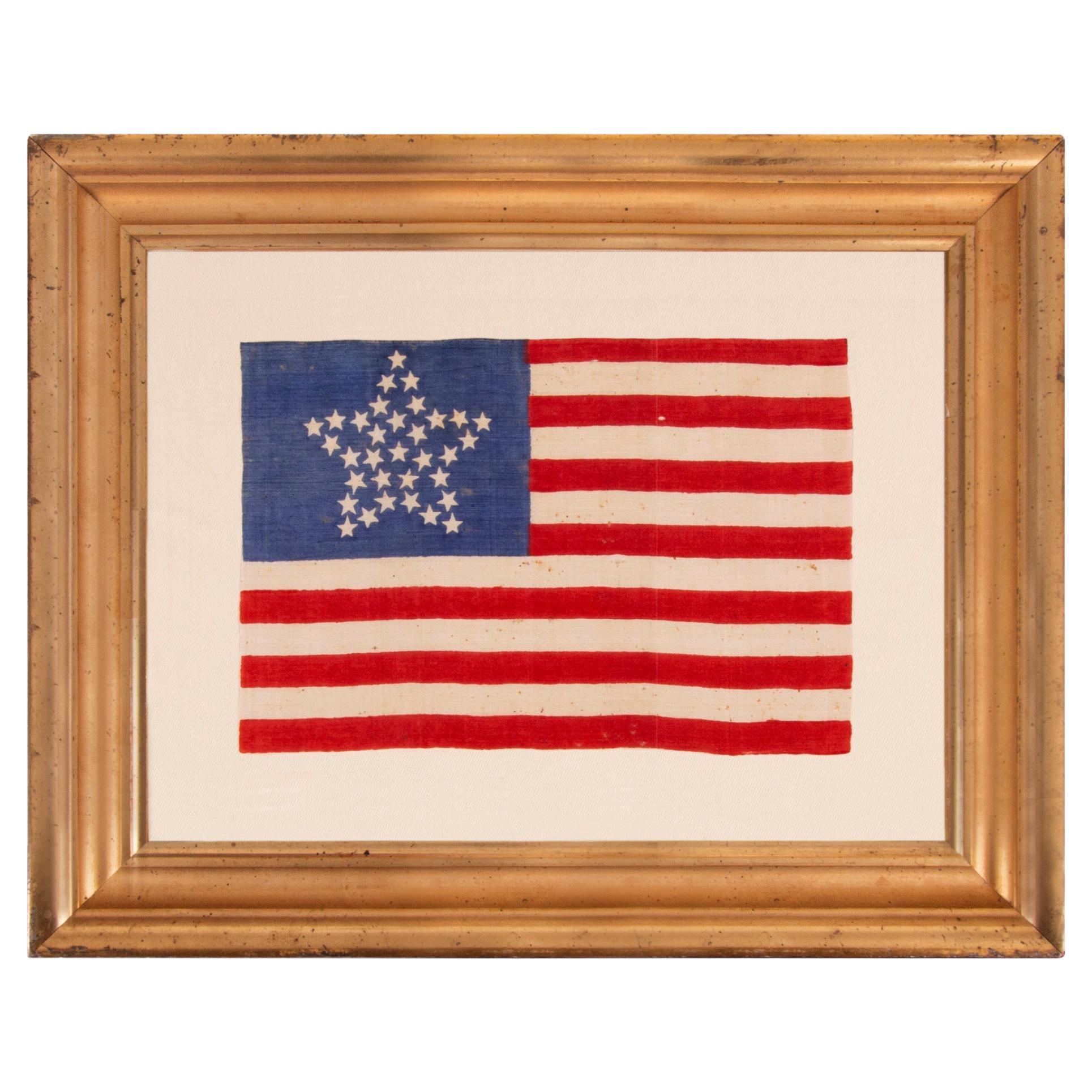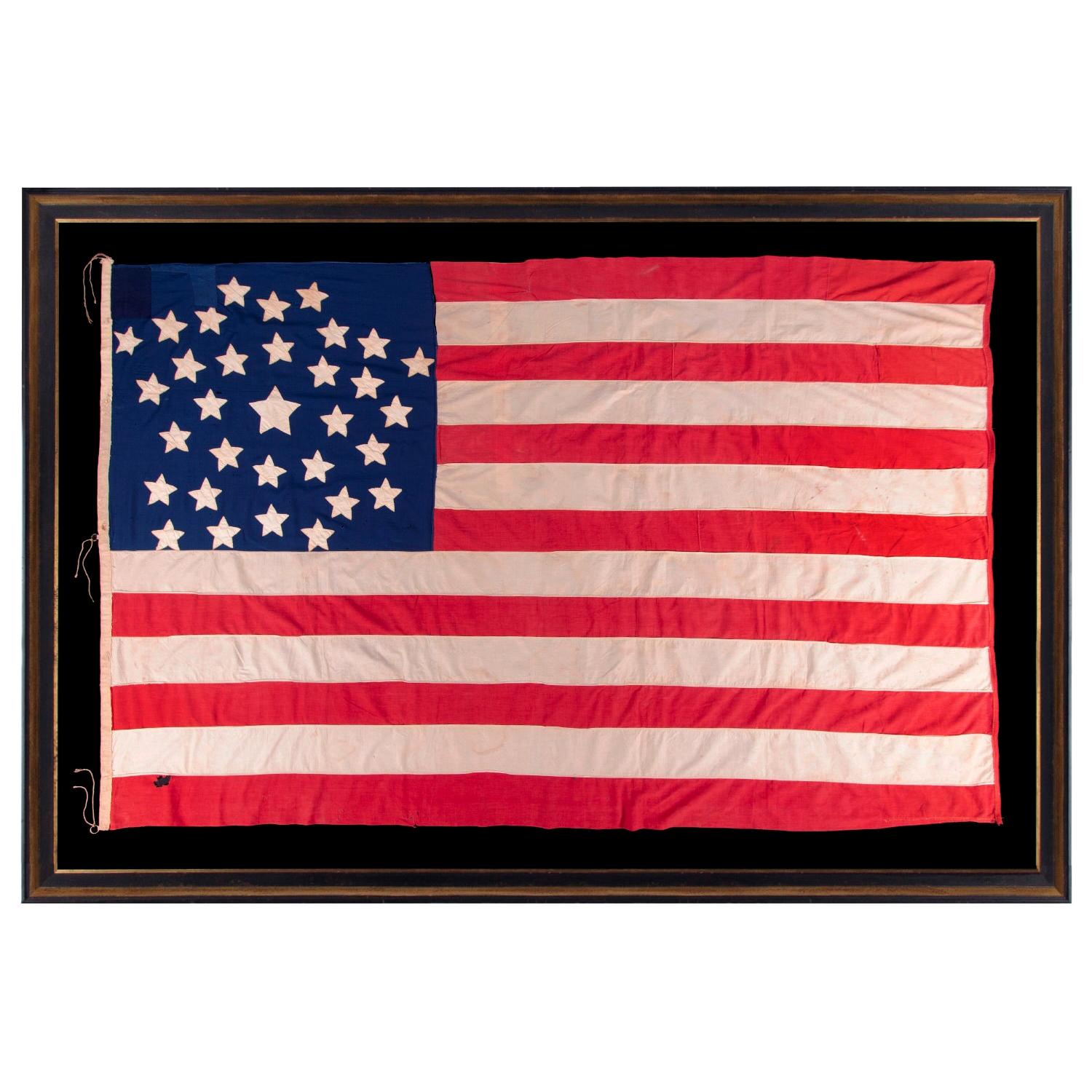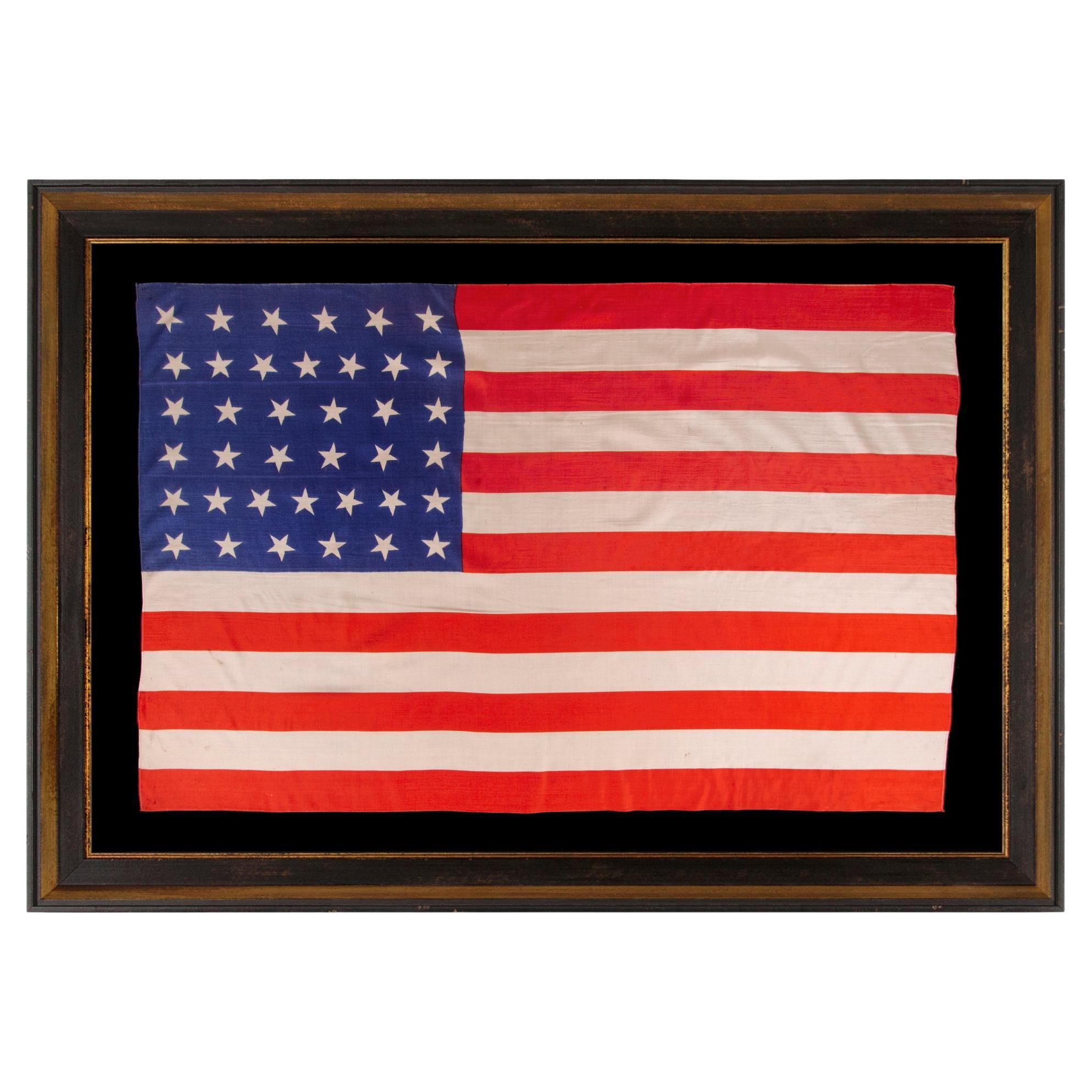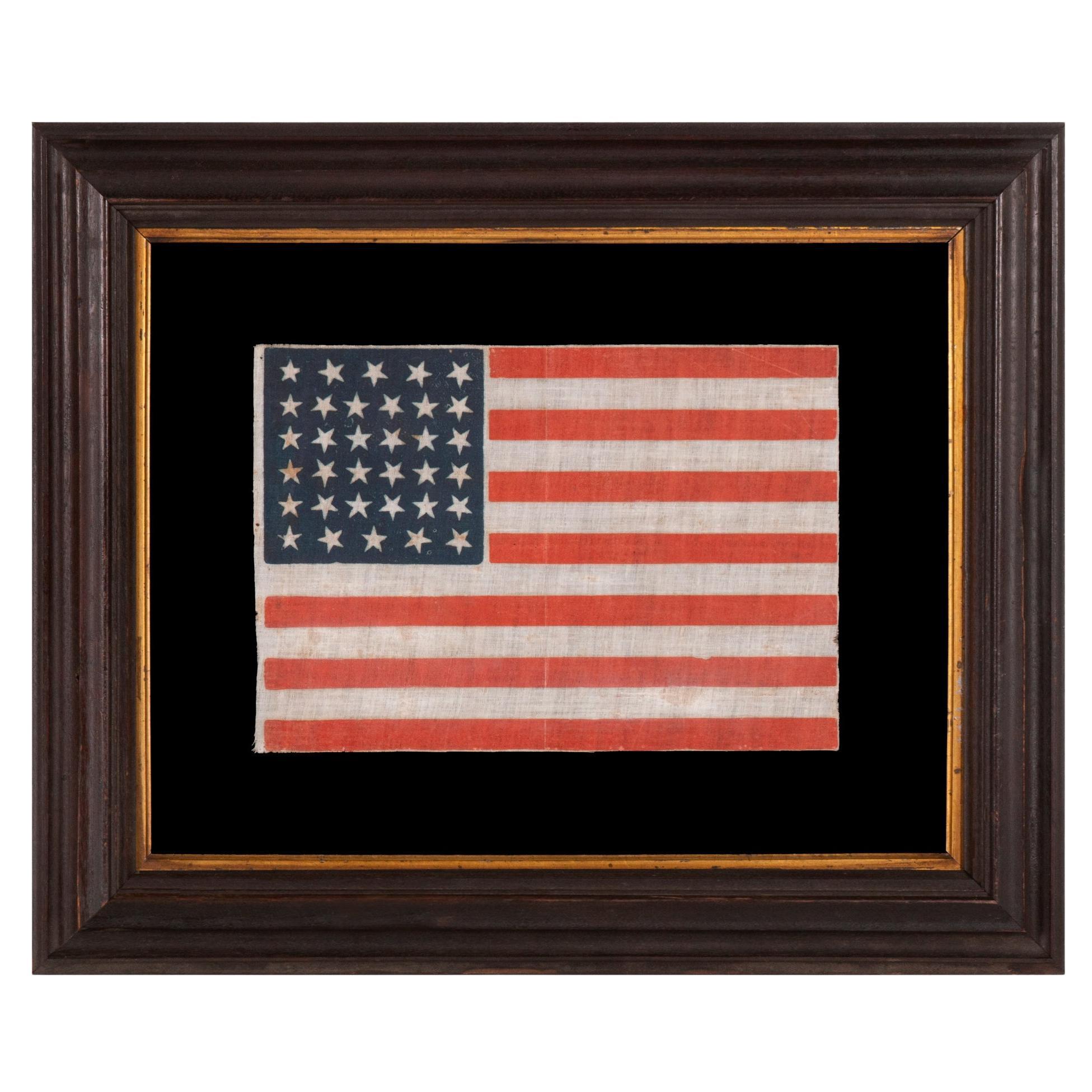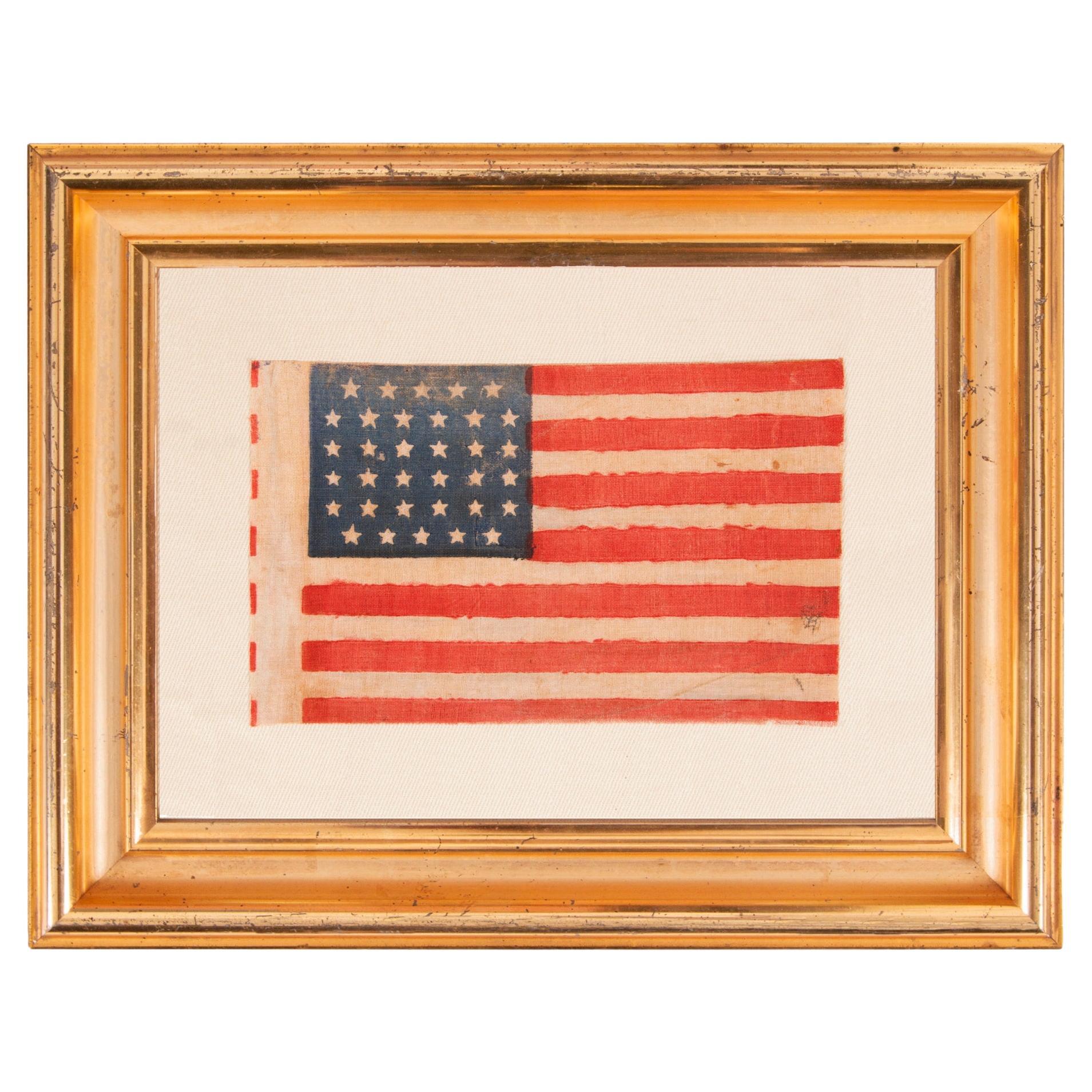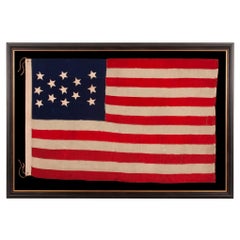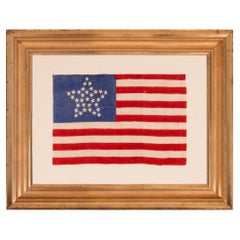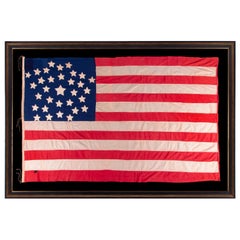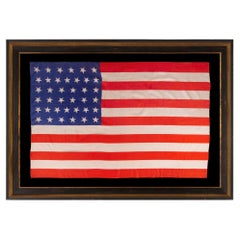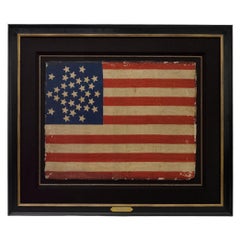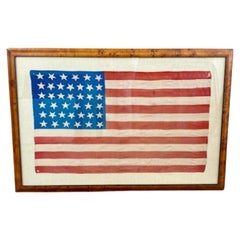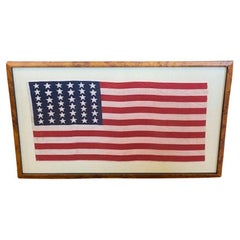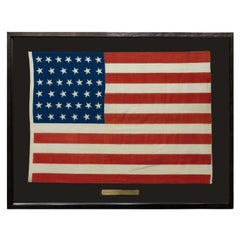Items Similar to 26 Star Antique American Flag, with 11 Stripes, Michigan Statehood, ca 1837-1846
Want more images or videos?
Request additional images or videos from the seller
1 of 7
26 Star Antique American Flag, with 11 Stripes, Michigan Statehood, ca 1837-1846
Price Upon Request
Price Upon Request
Price Upon Request
Price Upon Request
Price Upon Request
Price Upon Request
Price Upon Request
Price Upon Request
Price Upon Request
Price Upon Request
Shipping
Retrieving quote...The 1stDibs Promise:
Authenticity Guarantee,
Money-Back Guarantee,
24-Hour Cancellation
About the Item
26 STAR ANTIQUE AMERICAN PARADE FLAG WITH 11 STRIPES AND IT’S CANTON RESTING ON THE “WAR STRIPE.” THE EARLIEST KNOWN STAR COUNT FOR PRINTED EXAMPLES, 1837-1846, MICHIGAN STATEHOOD
26 star American parade flag, printed on cotton, hemmed at the top and bottom with hand-stitching.
The stars are arranged in 4 justified rows of 6, with 2 stars offset at the hoist end. Note how these roughly form two exaggerated “C’s”, a design that I have also sometimes offhandedly referred to as a “double bullet, seldom encountered in flags outside the 26 and 34 star counts. In the case of 26 star flags specifically, I have suggested that this star configuration may have actually been intended to form the letter “M” (tipped ninety degrees), to glorify Michigan, which joined the Union as the 26th state on January 26th, 1837. While this may not have been the intended purpose, the circumstance is certainly a curious one, and this seems to have been a popular way to arrange 26 stars.
Per the Third Flag Act (1818), stars were to be officially added to the flag on Independence Day following a state’s addition. The 26 star flag thus became official on July 4th, 1837, and remain so until July 3rd, 1845. Because no one paid much heed to official star counts, 26 star flags would have generally fell from use four months prior, on March 3rd, 1845, when Florida entered as the 27th state.
In terms of the production of American flags, this was an extremely early period. The very first printed examples, called “parade flags” or “hand-wavers,” displayed either 26 or 13 stars, the latter made during the same general period (1837-1845), but with an eye to our colonial past as opposed to representing the number of states at the time. Most surviving parade flags with 26 stars have political advertising for the presidential campaign of William Henry Harrison (1840), Henry Clay (1844), or James Polk (1844), or to support the 1844 platform of an emerging political faction known as the Native American Party. The remainder, without political overprints, like this flag, survive among less than 20 known examples. Most of the latter group are near-to-square in shape when compared to modern flags. This profile may mimic land-use, military battle flags of the 18th and 19th centuries, which bore this general shape. At the same time, one may note a keen similarity to the silk and cotton kerchiefs being produced during the same general era, likely carried or worn by women, in one fashion or another at parades and rallies. Whatever the case may be, most that I have encountered were at some point tacked to staffs in traditional parade flag format. That is the case with this example, as evidenced by tack marks at the top and bottom of the hoist and the ghostly shadow of a staff that runs into the first column of stars.
Another interesting trait can be seen in the fact that the canton rests on a red stripe. When this scarce condition occurs, some flag historians have referred to it as the “blood stripe” or the “war stripe”, suggesting the flag was constructed in this manner when the nation was at war. In actuality, the placement probably occurred more often by accident. Not everyone knew where the canton was traditionally placed, and because there was no official legislation regarding this facet of American flag design until 1912, there was no specified position. Here one may note that it rests on the 9th stripe. In any event, the war stripe feature is highly coveted by collectors and is particularly rare in printed examples.
Approximately 8 flags, including this one, are presently known to exist in this basic style, with this configuration. 4 of these are made of silk and are larger in scale. The remainder are cotton. 3 of the 4 cotton examples are in this particular style, with a large canton and the same placement.
It is of interest to note that a 9th flag is also known with the same configuration, but printed in waving format with a printed staff along the hoist end. While very different in this regard, the size and fabric are very much akin to the silk examples and were likely produced by the same maker. Some of the examples have the two offset stars on the fly end, as opposed to the hoist. One of the above bears only 11 stripes, though the remainder have the full complement of 13. All share the “blood stripe” feature.
The combination of a very early date, an intriguing star configuration, the war stripe feature, and the rarity of flags in the 26 star count in general, and its relevance to flag collecting as the earliest count on printed flags, combine to place this among the very best of parade flag examples.
Mounting: The flag was mounted and framed in our own conservation department, which is led by expert trained staff. We take great care in the mounting and preservation of flags and have framed thousands of examples. Feel free to contact us for more details.
The black-painted, hand-gilded and distressed molding is Italian. The glazing is U.V. protective acrylic (Plexiglas).
Condition: Three points along the hoist, where the flag was once attached to a wooden staff, were repaired with darning, apparently during its period of use. There is a darned repair in the upper, fly end corner, as well. There are weak areas and vertical tears elsewhere, adjacent to the fly end. There is a small hole near the fly end of the first white stripe and there are a couple of tiny tack holes elsewhere. There is overall golden brown oxidation throughout the white fabric, accompanied by minor to modest areas of staining in the canton, in limited areas, as well as throughout the striped field. There are slightly darker stains around the small hole and the 1st white stripe and in the 3rd red stripe. There are some weak areas in the lower, hoist and corner of the canton. Many of my clients prefer early flags to show their age and history of use. The overall condition is extraordinary in consideration of both its extreme rarity and the period in which it was made.
- Dimensions:Height: 33.25 in (84.46 cm)Width: 40.25 in (102.24 cm)Depth: 2.5 in (6.35 cm)
- Materials and Techniques:
- Place of Origin:
- Period:
- Date of Manufacture:1837-1846
- Condition:See Item Description.
- Seller Location:York County, PA
- Reference Number:Seller: 26j-8301stDibs: LU849740084192
About the Seller
5.0
Recognized Seller
These prestigious sellers are industry leaders and represent the highest echelon for item quality and design.
Established in 1991
1stDibs seller since 2008
70 sales on 1stDibs
Typical response time: 1 to 2 days
- ShippingRetrieving quote...Shipping from: York County, PA
- Return Policy
Authenticity Guarantee
In the unlikely event there’s an issue with an item’s authenticity, contact us within 1 year for a full refund. DetailsMoney-Back Guarantee
If your item is not as described, is damaged in transit, or does not arrive, contact us within 7 days for a full refund. Details24-Hour Cancellation
You have a 24-hour grace period in which to reconsider your purchase, with no questions asked.Vetted Professional Sellers
Our world-class sellers must adhere to strict standards for service and quality, maintaining the integrity of our listings.Price-Match Guarantee
If you find that a seller listed the same item for a lower price elsewhere, we’ll match it.Trusted Global Delivery
Our best-in-class carrier network provides specialized shipping options worldwide, including custom delivery.More From This Seller
View All13 Star Antique American Flag with a Narrow Star Presentation, ca 1876
Located in York County, PA
13 STAR ANTIQUE AMERICAN FLAG WITH HAND-SEWN STARS IN AN EXTREMELY NARROW PRESENTATION OF A 3-2-3-2-3 ARRANGEMENT ON A CANTON THAT DOESN’T FOLLOW SUIT, LEAVING WIDE EXPANSES OF BLUE ...
Category
Antique 1870s American Political and Patriotic Memorabilia
Materials
Wool
Price Upon Request
33 Star Antique American Flag with a Great Star Configuration, ca 1859-1861
Located in York County, PA
33 STARS ANTIQUE AMERICAN FLAG WITH A "GREAT STAR" CONFIGURATION ON A BRILLIANT, INDIGO BLUE CANTON, A RARE AND EXTRAORDINARY EXAMPLE, PRE-CIVIL WAR THROUGH THE WAR'S OPENING YEAR, 1...
Category
Antique Late 19th Century American Political and Patriotic Memorabilia
Materials
Silk
Antique American Flag, 32 Stars, Minnesota Statehood, circa 1858-59
Located in York County, PA
32 STARS IN A VERY UNUSUAL NOTCHED VERSION OF THE “GREAT STAR” PATTERN, WITH TWO STARS ABSENT AT THE EXTREME POINTS OF EACH ARM, MADE IN THE PERIOD WHEN MINNESOTA JOINED THE UNION AS...
Category
Antique 1850s American Political and Patriotic Memorabilia
Materials
Cotton
38 Star Antique American Flag, Colorado Statehood, circa 1876-1889
Located in York County, PA
38 star antique American parade flag with scattered star orientation, made of silk, with generous scale and vivid colors, Colorado Statehood, 1876-1889
38 star American national p...
Category
Antique Late 19th Century American Political and Patriotic Memorabilia
Materials
Silk
Price Upon Request
34 Star Antique American Parade Flag, Kansas Statehood, ca 1861-1863
Located in York County, PA
34 STARS, WITH SCATTERED POSITIONING, ON AN ANTIQUE AMERICAN PARADE FLAG MADE DURING THE OPENING TWO YEARS OF THE CIVIL WAR, 1861-63, KANSAS STATEHOOD
34 star American national flag...
Category
Antique 1860s American Political and Patriotic Memorabilia
Materials
Cotton
Price Upon Request
34 Star Antique American Parade Flag, Kansas Statehood, ca 1861-1863
Located in York County, PA
34 STAR ANTIQUE AMERICAN FLAG WITH A LINEAL ARRANGEMENT THAT I HAVE TERMED "GLOBAL ROWS, WITH EXCEPTIONAL COLOR AND CRUDE YET BEAUTIFUL FEATURES, OPENING TWO YEARS OF THE CIVIL WAR, ...
Category
Antique 1860s American Political and Patriotic Memorabilia
Materials
Cotton
Price Upon Request
You May Also Like
31-Star Printed American Flag, Celebrating California Statehood, Circa 1850
Located in Colorado Springs, CO
This is a rare 31-star medallion printed American flag, celebrating the addition of California to the Union. The flag is printed on silk and has a spectacular “Great Star” canton pat...
Category
Antique 1850s American Political and Patriotic Memorabilia
Materials
Silk
19th Century American 39 Star Flag, circa 1889
Located in Nantucket, MA
19th Century American 39 Star Flag, circa 1889, a period printed silk parade flag with a wavy pattern of dancing stars. This was never an official flag of the United States but was m...
Category
Antique 1880s American Federal Political and Patriotic Memorabilia
Materials
Silk
19th Century 39 Star American Flag, circa 1889
Located in Nantucket, MA
19th Century 39 Star American Flag, circa 1889, a printed linen ensign with 39 stars arranged in a wavy star pattern, with stripes in a very unus...
Category
Antique 1880s American Federal Political and Patriotic Memorabilia
Materials
Linen
39-Star Antique American Flag with 'Whimsical' Star Pattern, 1889
Located in Colorado Springs, CO
This is a 39-star unofficial American flag, handmade and printed on cotton. The flag dates to 1889 and has a unique history, thanks to its rare star-count.
The flag’s canton is prin...
Category
Antique 1880s American Political and Patriotic Memorabilia
Materials
Cotton
48-Star Printed American Flag, Commemorating Arizona Statehood, 1912-1958
Located in Colorado Springs, CO
This is an original 48-star American parade flag, celebrating Arizona statehood. A wonderful product of our nation's early history, this flag is an authentic antique, with a fly date...
Category
Mid-20th Century American Political and Patriotic Memorabilia
Materials
Fabric
45-Star American Flag, Printed on Cotton, Celebrating Utah Statehood, 1896-1908
Located in Colorado Springs, CO
This 45-star United States flag celebrates the statehood of Utah. 45-star flags served as the official American flag from 1896-1908. This particular flag was flown as a parade flag. ...
Category
Antique 1890s American Political and Patriotic Memorabilia
Materials
Cotton
More Ways To Browse
Used Furniture Michigan
Antique American Flags
Union Flag
Framed American Flags
Antique Furniture Michigan
19th Century American Flag
Antique Stripe Fabric
American Flag Cotton
Small American Flag
Antique American Flag Framed
Star Wars Prints
Staff Wooden Staff
Antique Advertising Collectibles
Antique Union Cases
Antique Military Memorabilia
Antique Hoist
Letter Scales
Train Memorabilia
